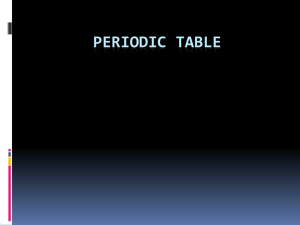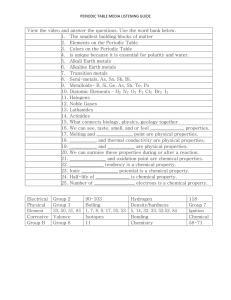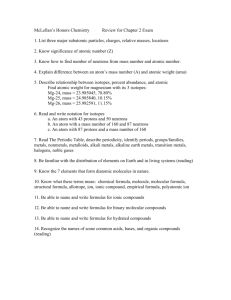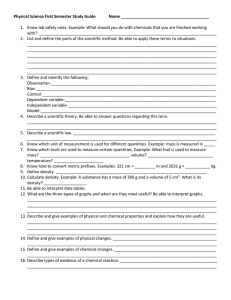Chapter 4 Assessment - Elements & the Periodic Table
advertisement
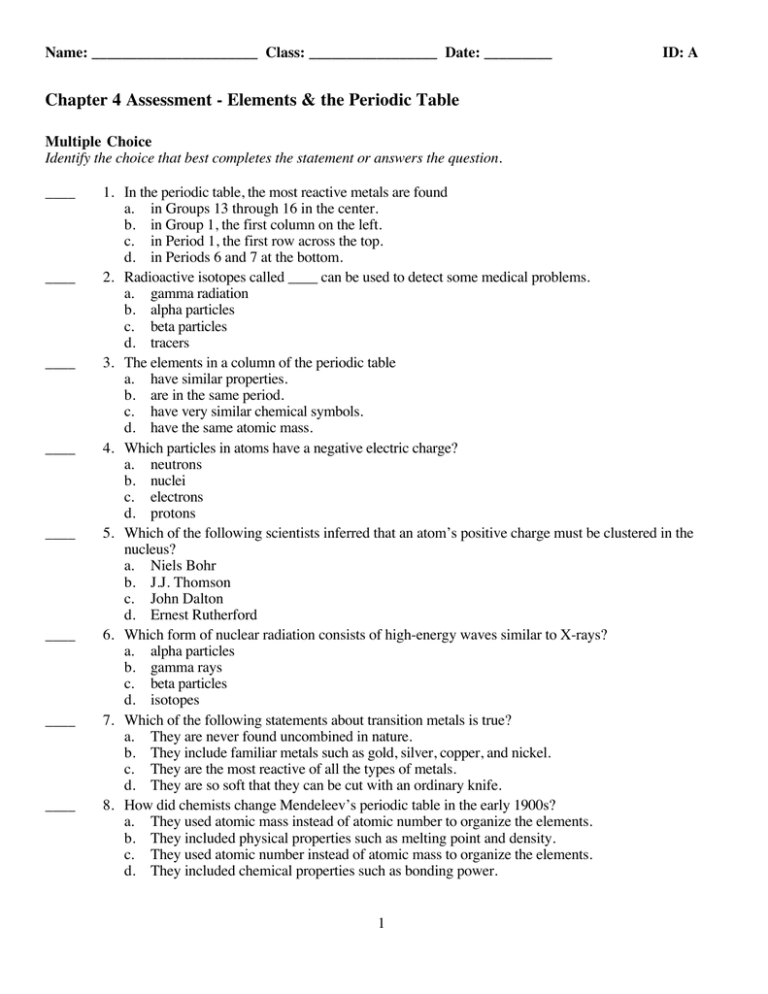
Name: ______________________ Class: _________________ Date: _________ ID: A Chapter 4 Assessment - Elements & the Periodic Table Multiple Choice Identify the choice that best completes the statement or answers the question. ____ ____ ____ ____ ____ ____ ____ ____ 1. In the periodic table, the most reactive metals are found a. in Groups 13 through 16 in the center. b. in Group 1, the first column on the left. c. in Period 1, the first row across the top. d. in Periods 6 and 7 at the bottom. 2. Radioactive isotopes called ____ can be used to detect some medical problems. a. gamma radiation b. alpha particles c. beta particles d. tracers 3. The elements in a column of the periodic table a. have similar properties. b. are in the same period. c. have very similar chemical symbols. d. have the same atomic mass. 4. Which particles in atoms have a negative electric charge? a. neutrons b. nuclei c. electrons d. protons 5. Which of the following scientists inferred that an atom’s positive charge must be clustered in the nucleus? a. Niels Bohr b. J.J. Thomson c. John Dalton d. Ernest Rutherford 6. Which form of nuclear radiation consists of high-energy waves similar to X-rays? a. alpha particles b. gamma rays c. beta particles d. isotopes 7. Which of the following statements about transition metals is true? a. They are never found uncombined in nature. b. They include familiar metals such as gold, silver, copper, and nickel. c. They are the most reactive of all the types of metals. d. They are so soft that they can be cut with an ordinary knife. 8. How did chemists change Mendeleev’s periodic table in the early 1900s? a. They used atomic mass instead of atomic number to organize the elements. b. They included physical properties such as melting point and density. c. They used atomic number instead of atomic mass to organize the elements. d. They included chemical properties such as bonding power. 1 Name: ______________________ ____ ____ ____ ____ ____ ____ ____ ____ ____ ID: A 9. Which group contains the most elements? a. transition elements b. nonmetals c. semimetals d. metals 10. The elements that do not ordinarily form compounds are a. inert gases. b. metals. c. halogens. d. elements in the carbon family. 11. A piece of paper will provide protection from a. beta radiation. b. gamma rays. c. gamma radiation. d. alpha radiation. 12. What information in the periodic table indicates the number of protons in an atom? a. the element’s chemical symbol b. the position of the element in its column c. the element’s atomic mass d. the element’s atomic number 13. The reason radioactive isotopes can be followed through the steps of a chemical reaction or industrial process is that they a. are stable. b. do not decay. c. give off radiation. d. do not react chemically as nonradioactive isotopes do. 14. A material is said to be ductile if it a. can transfer heat or electricity to another material. b. can be hammered or rolled into flat sheets and other shapes. c. can be pulled out, or drawn, into a long wire. d. is a mixture of a metal with at least one other element. 15. Most metals are NOT a. ductile. b. malleable. c. liquid at room temperature. d. good conductors of heat and electricity. 16. The most useful property of semimetals is their a. varying ability to conduct electricitic current. b. softness and malleability. c. tendency to be unreactive. d. ability to be pulled out into long wires. 17. Which group of elements shares characteristics with both metals and nonmetals? a. halogens b. lanthanides c. salts d. semimetals 2 Name: ______________________ ____ ____ ____ ____ ____ ____ ID: A 18. During radioactive decay, atomic nuclei of unstable isotopes a. form chemical bonds. b. give off nuclear radiation. c. are unchanged. d. are broken down by radioactive bacteria. 19. In general, which of the following statements about metals is true? a. Metals show a wide range of chemical properties. b. Metals are highly reactive substances. c. Metals need to be stored in sealed containers for safety. d. Metals do not react with oxygen. 20. In 1896, the French scientist Henri Becquerel discovered a. a process to turn natural rubber into a hard, stretchable polymer. b. light-emitting polymers. c. radioactive decay. d. how to make alloys. 21. In an atom, the number of protons equals the number of a. neutrons. b. nuclei. c. isotopes. d. electrons. 22. Mendeleev created the first periodic table by arranging elements in order of a. increasing atomic mass. b. decreasing atomic mass. c. increasing melting points and densities. d. increasing atomic number. 23. Fluorine, chlorine, bromine, and iodine are part of a family called a. alkali metals. b. semimetals. c. halogens. d. inert gases. 3 Name: ______________________ ID: A Use the diagram to answer each question. Atoms of Some Common Elements Element Atomic Number Atomic Mass (Mass Number) Protons Neutrons Electrons Sodium 11 ? 11 12 ? Magnesium 12 24 12 ? 12 Aluminum ? 27 13 14 13 Phosphorus 15 31 ? 16 15 24. How many neutrons are in an atom of magnesium? 25. What is the atomic number (mass number) of sodium? 26. What is the total number of electrons in an atom of sodium? 27. What is the atomic number of aluminum? 28. How many protons are in an atom of phosphorus? Use the diagram to answer each question. 29. Which group of elements reacts violently with elements from Group 1? 30. If a metal reacts violently with water, in which group is it likely to be found? 31. Most of the elements that form a zigzag line in the periodic table belong to one major group. What is that group, and what kinds of properties do its elements tend to have? 32. What name is given to the elements in Groups 3 through 12? How do their properties tend to compare with the elements to the left and right of these groups? 33. Locate the box in Group 18 in the fourth period. Predict the state of matter and the chemical reactivity of the element that belongs in that box. 4 ID: A Chapter 4 Assessment - Elements & the Periodic Table Answer Section MULTIPLE CHOICE 1. 2. 3. 4. 5. 6. 7. 8. 9. 10. 11. 12. 13. 14. 15. 16. 17. 18. 19. 20. 21. 22. 23. B D A C D B B C D A D D C C C A D B A C D A C SHORT ANSWER 24. 25. 26. 27. 28. 29. 30. 31. 32. 12 23 11 13 15 Group 17 Group 1 Semimetals. Semimetals have some properties of metals and some properties of nonmetals. Transition metals. They are less reactive than the metals in Groups 1 and 2 to their left; they tend to be more reactive than the metals to their right. 33. The element is a gas, one of the inert gases. It does not ordinarily react with other elements to form compounds. 1

